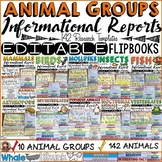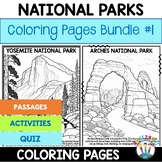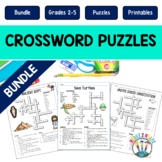21 results
Physical science Common Core 7.RP.A.2 resources
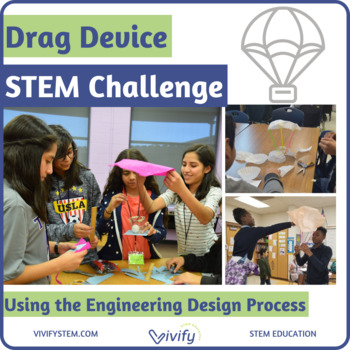
STEM Drag Device Parachute Challenge (Engineering Design Activity)
Drag Device STEM Parachute Activity Students use the engineering design process and explore the forces of gravity and air resistance to design a drag device to slow down a payload. This challenge uses a ping pong ball to represent a rover landing on Mars. The rover must remain inside an uncovered cup during drop and impact testing. This hands-on activity is an engaging design challenge that allows students to work in teams, apply the engineering design process, and connect math topics to real-wo
Subjects:
Grades:
2nd - 8th
Types:
NGSS:
MS-ETS1-2
, 3-5-ETS1-3
, 3-5-ETS1-1
, MS-ETS1-1
, 3-5-ETS1-2
...
Also included in: Space STEM Starter Challenges MEGA Bundle: Middle School
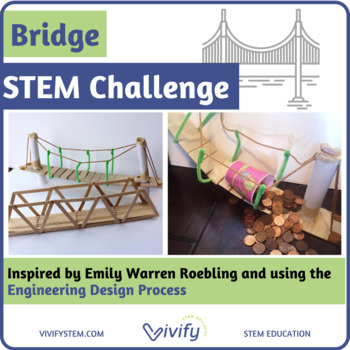
Bridge Engineering STEM Challenge - Women in STEM History Activity (Digital)
This engaging STEM challenge is a fun way to incorporate the engineering design process into your classroom or afterschool program! Students use the engineering design process and explore compression and tension forces in bridges while building their own bridge! This challenge also highlights Emily Roebling, the first woman field engineer who was instrumental in the construction of the Brooklyn Bridge. History, science, engineering, literature (optional), and math-- it is all included along with
Subjects:
Grades:
6th - 12th
Types:
Also included in: Women in STEM History Engineering Challenges Bundle

Spider Parachute Halloween STEM Activity
Design a parachute to save a spider! This is a fun Halloween STEM activity that your students will love with a version for distance learning! When some spiders are born, they make parachutes out of their silk in order to safely drop from their mother’s web. They release a few strands of silk that form a triangular-shaped parachute that catches the breeze and lifts them in the air! But in our challenge today, one of the baby spiders is unable to deploy their parachute and needs your help to get d
Subjects:
Grades:
2nd - 8th
Types:
NGSS:
K-2-ETS1-2
, K-2-ETS1-3
, MS-ETS1-2
, K-2-ETS1-1
, 3-5-ETS1-3
...
Also included in: Fall & Halloween STEM Challenges Activity Bundle
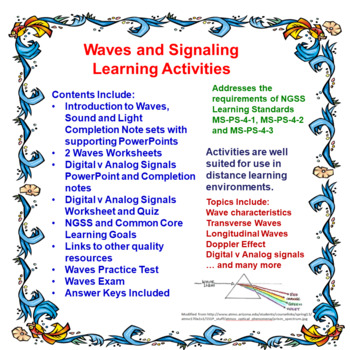
Waves (sound/light) and Signaling Learning Activities
This learning activities package on Waves and Signaling contains four PowerPoints with associated completion notes, a student practice test, one unit tests and worksheets. It also contains links to other videos, animations and lab activities.Some of the topics addressed in this waves unit include transverse and longitudinal waves including wave terminology, the nature of light waves, reflection and the law of reflection, refraction, sound and factors influencing its travel, the Doppler effect,
Grades:
5th - 8th
NGSS:
MS-PS4-1
, MS-PS4-2
, MS-PS4-3
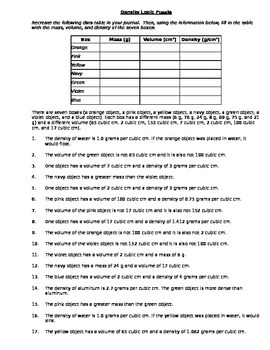
Density Logic Puzzle
This activity is a fun way for students to practice basic density calculations (p=m/v) while building in some critical thinking skills as well. Students are provided a series of clues about 7 different colored boxes and students need to determine which of the seven provided masses, volumes, and densities is connected tot hat color box.
For example, "The density of water is 1.0 grams per cubic cm. If the orange object was placed in water, it would float."
There is a table for students to fil
Grades:
7th - 10th
Types:
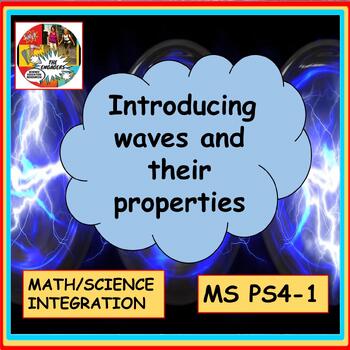
Introducing waves and their properties MS PS4-1
These engaging lessons (GOOGLE and PDF versions) allow students to develop a concrete understanding of the two different types of waves that make up sound and light, the properties of these waves, and the relationship between amplitude and energy.This activity supports the NGSS standard MS PS4-1These lessons support the math standards 6.RP.A.3 and 7.RP.A.2A number of activities (shown below) are included in these lessons to foster student understanding:Students will:Use a slinky to explore the t
Subjects:
Grades:
6th - 9th
Types:
NGSS:
MS-PS4-1
Also included in: Waves and Electromagnetic Radiation Unit Bundle NGSS CER
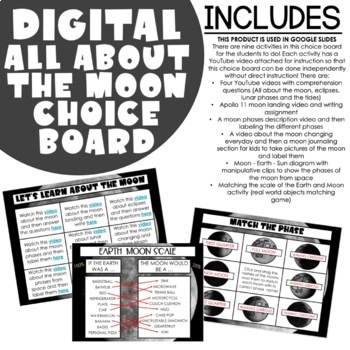
All About The Moon Choice Board - Google Slides - Distance Learning
This product is a digital download in google slides that allows for an easy google classroom upload! It can be used through the week as a warm up each day, it can be used as a project for the week, or it can be used as nightly homework! Whichever you choose! There are nine activities in this choice board for the students to do! Each activity has a youtube video attached for instruction so that this choice board can be done independently without direct instruction! There are;Four youtube videos w
Grades:
3rd - 12th
Types:
NGSS:
MS-ESS1-3
, MS-ESS1-1
Also included in: INTRODUCTION TO SPACE - Three bundled activities
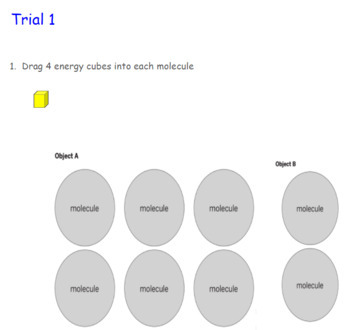
Thermal Energy: Modeling Temperature, Thermal Energy, and Equilibrium
Goal: Demonstrate the difference between average kinetic energy, total kinetic energy, and temperature.This is a modeling tool that is converted into a virtual activity from Amplify Science Thermal Energy Lesson 3.2.Students Learn:For things at the same temperature, the thing with more molecules has more total kinetic energy (thermal energy) than the thing with fewer molecules.At equilibrium, the average kinetic energy (temperature) of the molecules in the system is the total kinetic energy (the
Subjects:
Grades:
6th - 8th
NGSS:
MS-PS3-4
, MS-PS3-3
, MS-PS3-5
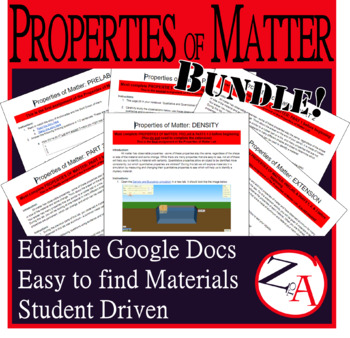
Properties of Matter Lab BUNDLE
Interested in PrBL/PBL? Want to get students engaged in learning about matter while still holding them accountable?This lab introduces some of the properties of matter and gives students an overview of qualitative and quantitative observations, intrinsic and extrinsic properties, and density and buoyancy. Students use readings, observations, lab work, and simulations to explore properties of matter.The lab is split into 5 parts along with one lab-based extension. Students can work through the la
Subjects:
Grades:
7th - 9th
Types:
NGSS:
5-PS1-3
, MS-PS1-2
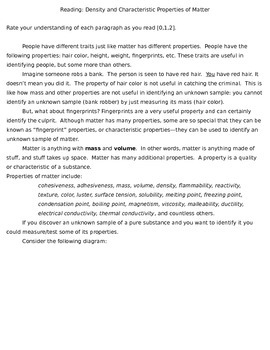
STEM/NGSS: Properties of Matter Density and Its Characteristics READING
What makes density a unique property? This reading details why density is a characteristic property and why it can therefore be used to identify unknown materials.Reading includes a metacognitive strategy for reading comprehension, and is followed by two problems to solve.Includes examples of proportional reasoning to meet common core standards.Enjoy, and spread the word if you like it!
Subjects:
Grades:
6th - 10th, Higher Education
Types:
NGSS:
MS-PS1-1
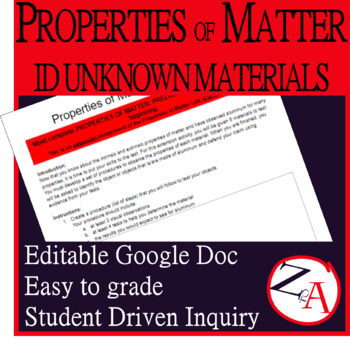
Properties of Matter: Identifying Unknown Materials (EXTENSION)
Interested in PrBL/PBL? Want to get students engaged in learning about matter while still holding them accountable?This Extension Lab allows students to use their newfound knowledge of the properties of matter to identify unknown materials.Students write their own procedures and develop their own tests to identify which substances are aluminum!This extension lab is designed to let students practice and apply their knowledge of the properties of matter. It is an extension activity in a 5 part lab
Subjects:
Grades:
8th - 9th
Types:
NGSS:
5-PS1-3
, MS-PS1-2
Also included in: Properties of Matter Lab BUNDLE
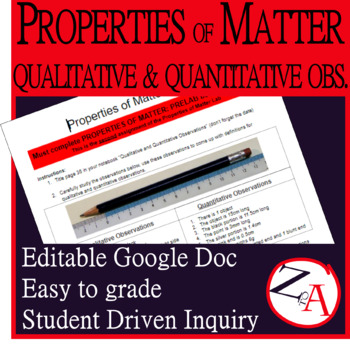
Properties of Matter: Qualitative & Quantitative Observation (PART 1)
Interested in PrBL/PBL? Want to get students engaged in learning about matter while still holding them accountable?This Lab (Part 1) introduces students to Qualitative and Quantitative observations with an inquiry approach.Students look at observations made by another student, then use those observations to define qualitative and quantitative and to make their own observations!This part of the lab is designed to get students ready to observe the properties of matter. It is the second activity in
Subjects:
Grades:
8th - 9th
Types:
NGSS:
5-PS1-3
, MS-PS1-2
Also included in: Properties of Matter Lab BUNDLE
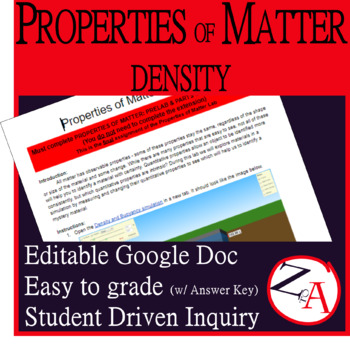
Properties of Matter: Inquiry Finding Density & Observing Buoyancy (DENSITY)
Interested in PrBL/PBL? Want to get students engaged in learning about matter while still holding them accountable?This Lab introduces students to density as an intrinsic property (at standard pressure and temperature).Students use a simulation to explore the relationship between volume, mass, density, and buoyancy with an inquiry approach.This lab is designed to engage students in learning about density as a property of matter. It is the fifth activity in a 5 part lab.This Lab also works well a
Subjects:
Grades:
8th - 9th
NGSS:
5-PS1-3
, MS-PS1-2
Also included in: Properties of Matter Lab BUNDLE
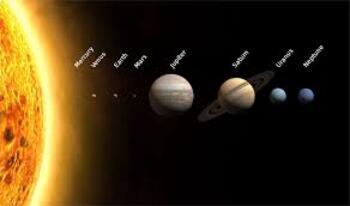
Build A Scale Model of the Solar System
Objective: create a scale model of the solar system (planets only) showing -Part 1: The relative sizes (diameters) of the planets -Part 2: The relative distances of the planets from the sunMaterials 1 piece of paper [100cm x 50cm] scrap paper to cut upscissors metric ruler online resourcescompass mechanical pencil
Subjects:
Grades:
6th - 9th
Types:
NGSS:
MS-ETS1-2
, MS-ETS1-4
, MS-ESS1-3

Matter and Data Review
This download is a 1 page review (+1 page key) designed for a refresher session on basic Matter (vs. Energy) and Data (focus on Quantitative) concepts. The introduction of my procedures (Mnemonics + Roadmap) for Metric System relationships is also highlighted. A key for the review for your own use or as a correction reference for students is included in this downloaded as well.Regardless if you choose to download, just view, or even provide feedback/review, I thank you for taking the time to do
Subjects:
Grades:
6th - 12th
CCSS:
NGSS:
MS-PS1-5

Dimensional Analysis Notes and Activity
This product includes everything you need for a complete lesson on basic dimensional analysis with a focus on unit conversions. Included in the download: a guided notes worksheet for students, a sheet of practice problems (could be homework) and an activity for students to practice conversions. All conversions needed to complete the activity are included in the conversion chart. The target age group for this package is middle and upper school students (grades 7+), and can be used in math or scie
Subjects:
Grades:
7th - 12th
Types:

STEM/NGSS: Properties of Matter Drawing Density Models Exercise #1
Student is given information about a sample and is then asked to draw a model of it:Sample A has twice the mass of Sample B, but has the same volume. Draw it.
Subjects:
Grades:
7th - 12th
Types:
NGSS:
MS-ETS1-2
, MS-ETS1-4
, HS-PS2-1
, MS-ETS1-3
, MS-PS1-1
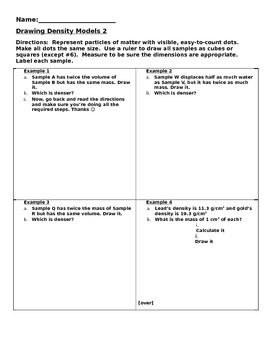
STEM/NGSS: Properties of Matter Drawing Density Models Exercise #2
Student is given information about a sample and is then asked to draw a model of it:Sample A has twice the mass of Sample B, but has the same volume. Draw it.This worksheet supplements Drawing Density Models #1.
Grades:
7th - 12th, Adult Education
Types:
NGSS:
HS-PS2-1
, MS-PS1-1

Properties of Matter: Thinking Questions (PART 3)
Interested in PrBL/PBL? Want to get students engaged in learning about matter while still holding them accountable?This Lab introduces students to intrinsic and extrinsic properties of matter.Students brainstorm how they might identify their Mystery Material from Part 2 based on its properties!This part of the lab is designed to get students thinking about intrinsic properties of matter. It is the fourth activity in a 5 part lab.This part of the lab can also work as a stand alone assignment to h
Subjects:
Grades:
8th - 9th
Types:
NGSS:
5-PS1-3
, MS-PS1-2
Also included in: Properties of Matter Lab BUNDLE

Properties of Matter: Observing a Mystery Material (PART 2)
Interested in PrBL/PBL? Want to get students engaged in learning about matter while still holding them accountable?This Lab introduces students to the Mystery Material (aluminum)- they then practice taking many different types of qualitative observations.Students travel to 3 stations to observe different properties of the Mystery Material.This part of the lab is designed to get students practicing observations and starting to identify properties of matter. It is the third activity in a 5 part la
Subjects:
Grades:
8th - 9th
Types:
NGSS:
5-PS1-3
, MS-PS1-2
Also included in: Properties of Matter Lab BUNDLE
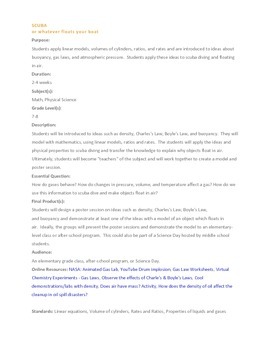
SCUBA - or whatever floats your boat
Students will be introduced to ideas such as density, Charles's Law, Boyle's Law, and buoyancy. They will model with mathematics, using linear equations, ratios and rates. The students will apply the ideas and physical properties to scuba diving and transfer the knowledge to explain why objects float in air. Ultimately, students will become "teachers" of the subject and will work together to create a model and poster session.
Subjects:
Grades:
7th - 10th
Types:
Showing 1-21 of 21 results

